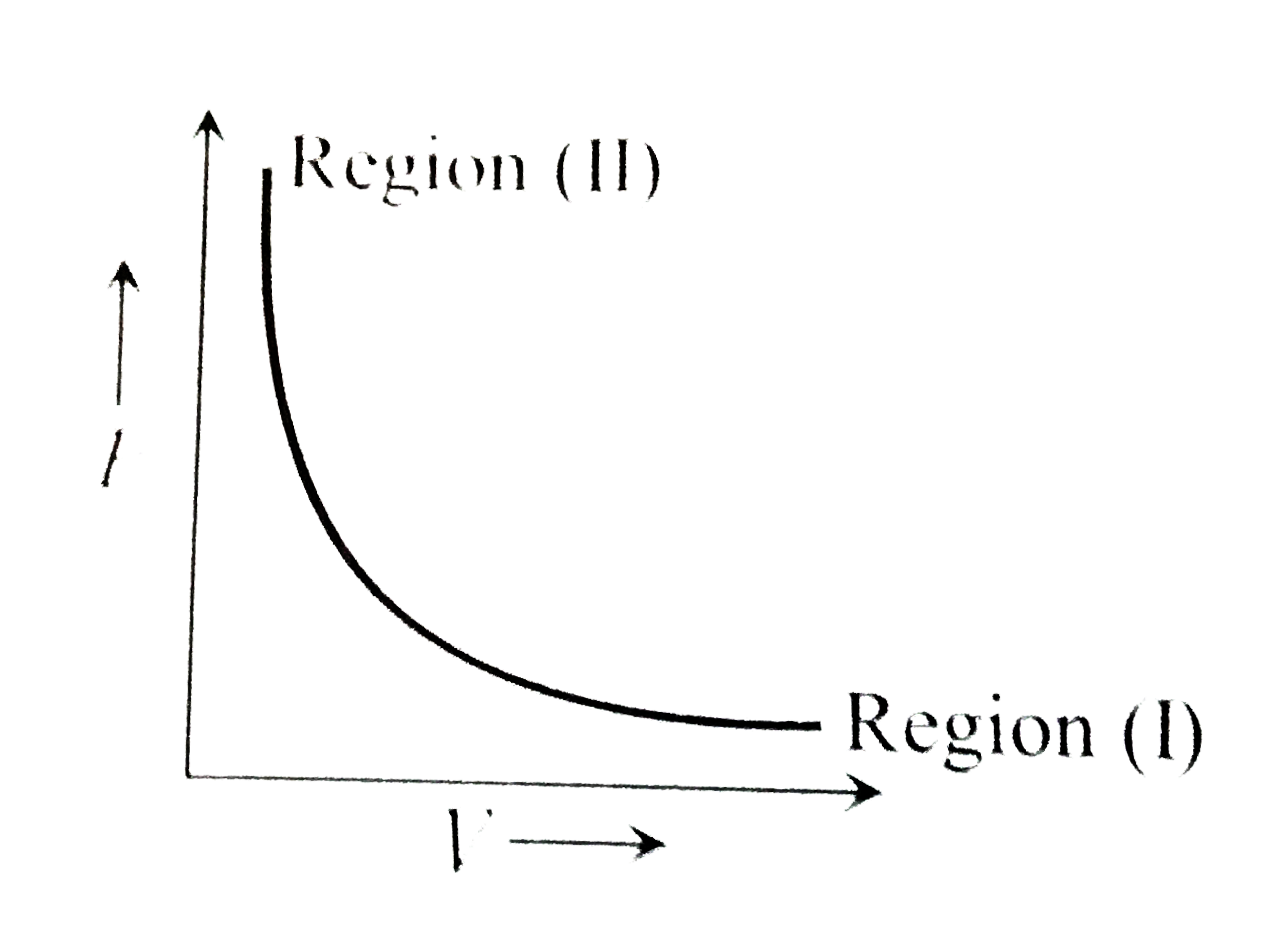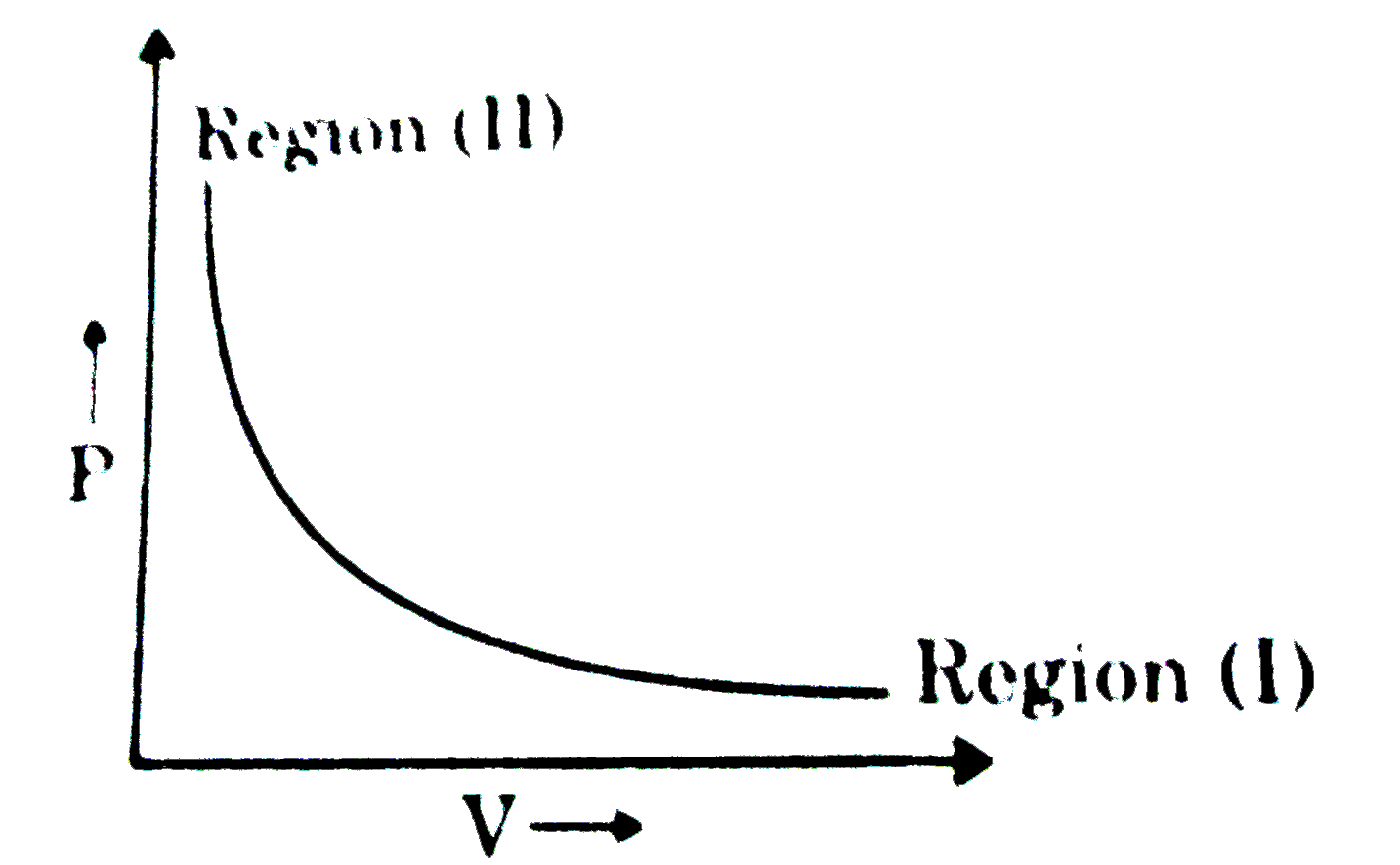One of the approach to the study of real gases involves the analysis of a parameter Z called the compressibility factor Z=PVmRT where P is pressure, Vm is molar volume, T is absolute temperature and R is the universal gas constant . Such a relation can also be expressed as Z=(Vm realVm ideal) (where Vm ideal and Vm real are the molar volume for ideal and real gas respectively) . Gas corresponding Z>1 have repluive tendenciesamong constituent particles due to their size factor, among constitutent particles . As the pressure is lowered or temperature is increased the value of Z approaches 1. ( reaching the ideal behaviour)
Following graph represents a pressure (P ) volume (V ) relationship at a fixed temperature (T ) for n moles of a real gas. The graph has two regions marked (I) and (II). Which of th following options is true.

Z<1 in the reion (II)
Z= in the region (II)
Z=1 for the curve
Z approaches 1 as we move from region (II) to region (I)
The correct Answer is:D
On moving from region (II) to region (I), pressure tends to zero. So, Z→1.
Topper's Solved these Questions
- GASEOUS STATE BOOK - ERRORLESS CHAPTER - GASEOUS STATE EXERCISE - JEE SECTION (Integer type questions)
7 Videos
- GASEOUS STATE BOOK - ERRORLESS CHAPTER - GASEOUS STATE EXERCISE - JEE SECTION (Matrix Match type questions)
3 Videos
- GASEOUS STATE BOOK - ERRORLESS CHAPTER - GASEOUS STATE EXERCISE - JEE SECTION Comprehension type question (Passage-I)
2 Videos
- ENVIRONMENTAL CHEMISTRYBOOK - ERRORLESS CHAPTER - ENVIRONMENTAL CHEMISTRYEXERCISE - CRITICAL THINKING (Objective question )
16 Videos
- GENERAL ORGANIC CHEMISTRYBOOK - ERRORLESS CHAPTER - GENERAL ORGANIC CHEMISTRYEXERCISE - Matrix Match type questions
4 Videos
Similar Questions
One of the important approach to the study of real gases involves the analysis of parameter Z called the compressibility factor Z=PVmRT where P is pressure, Vm is molar volume, T is absolute temperature and R is the universal gas constant. such a relation can also be expressed as Z=(VmrealVmal) (where Vmal and Vmreal are the molar volume for ideal and real gas respectively). Gas corresponding Z<1 have attractive forces amoung constituent particles. As the pressure is lowered or temperature is increased the value of Z approaches 1. (reaching the ideal behaviour)
For a real gas GZ>1 at STP Then for 'G': Which of the following is true:
View SolutionOne of the important approach to the study of real gases involves the analysis of parameter Z called the compressibility factor Z=PVmRT where P is pressure, Vm is molar volume, T is absolute temperature and R is the universal gas constant. such a relation can also be expressed as Z=(VmrealVmal) (where Vmal and Vmreal are the molar volume for ideal and real gas respectively). Gas corresponding Z<1 have attractive forces amoung constituent particles. As the pressure is lowered or temperature is increased the value of Z approaches 1. (reaching the ideal behaviour)
ObservationConclusionI.Z=1I.The gas need not be showing the ideal behaviourII.Z>1II.On applying pressure the gas will respond byincreasing its volumeIII.Z<1III.The gas may be liquefiedIV.Z→1for lowPIV.The gas is approaching the ideal behaviour
View Solution
Knowledge Check
One of the approach to the study of real gases involves the analysis of a parameter Z called the compressibility factor Z=PVmRT where P is pressure, Vm is molar volume, T is absolute temperature and R is the universal gas constant . Such a relation can also be expressed as Z=(Vm realVm ideal) (where Vm ideal and Vm real are the molar volume for ideal and real gas respectively) . Gas corresponding Z>1 have repluive tendenciesamong constituent particles due to their size factor, among constitutent particles . As the pressure is lowered or temperature is increased the value of Z approaches 1. ( reaching the ideal behaviour)
For a real gas 'G'Z>1 at STP then for 'G' which of the following is trueA1 mole of the gas occupies 22.4 L at NTPB1 mole of the gas occupies 22.4 L at pressure higher than that at STP (keeping temperature constant)C1 mole of the gas occupies 22.4 L at pressure lower than that at STP ( keeping temperature constant)DNone of the aboveOne of the important approach to the study of real gases involves the analysis of parameter Z called the compressibility factor Z=PVmRT where P is pressure, Vm is molar volume, T is absolute temperature and R is the universal gas constant. such a relation can also be expressed as Z=(VmrealVmal) (where Vmal and Vmreal are the molar volume for ideal and real gas respectively). Gas corresponding Z<1 have attractive forces amoung constituent particles. As the pressure is lowered or temperature is increased the value of Z approaches 1. (reaching the ideal behaviour)
Following graph represents a pressure (P) volume (V) relationship at a fixed temperature (T) for n moles of a real gas. The graph has two regions marked (I) and (II). Which of the following options is true.
 AZ<1 in the region (II)BZ=1 I the region (II)CZ=1 for the curveDZ approaches 1 as we move from region (II) to region (I)
AZ<1 in the region (II)BZ=1 I the region (II)CZ=1 for the curveDZ approaches 1 as we move from region (II) to region (I)One of the important approach to the study of real gases involves the analysis of parameter Z called the compressibility factor Z=PVmRT where P is pressure, Vm is molar volume, T is absolute temperature and R is the universal gas constant. such a relation can also be expressed as Z=(VmrealVmal) (where Vmal and Vmreal are the molar volume for ideal and real gas respectively). Gas corresponding Z<1 have attractive forces amoung constituent particles. As the pressure is lowered or temperature is increased the value of Z approaches 1. (reaching the ideal behaviour)
For a real gas GZ>1 at STP Then for 'G': Which of the following is true:A1 mole of the gas occupies 22.4 L at NTPB1 mole of the gas occupies 22.4 L at pressure higher than that at STP (keeping temperature constant)C1 mole of the gas occupies 22.4 L at pressure lower than that at STP (keeping temperature constant)DNone of the above
One of the important approach of the study of real gases involves the analysis of a parameter Z called the compressibility factor Z=PVmRT where P is pressure, Vm is molar volume ,T is absolute temperature and R is the universal gas constant .Such a relation can also be expressed as Z=(V m realVm ideal) (where Vm ideal and V_("m real")arethemo≤rvolumeforalandrealgasrespectivelytendenciesamongconstituentpartic≤s.Aspressureisforceamongisloweredortemperatureis∈creasedthevalueofZapproachesalbehaviour<br>Forarealgas'G',Zgt1 at STP, then for 'G' which of the following is true ?
View SolutionOne of the important approach of the study of real gases involves the analysis of a parameter Z called the compressibility factor Z=PVmRT where P is pressure, Vm is molar volume ,T is absolute temperature and R is the universal gas constant .Such a relation can also be expressed as Z=(V m realVm ideal) (where Vm ideal and V_("m real") are the moler volume for ideal and real gas respectively tendencies among constituent particles.As pressure is force among is lowered or temperature is increased the value of Z approaches ideal behaviour
Choose the conslusions which are appropriate for the observation stated
View SolutionOne of the important approach of the study of real gases involves the analysis of a parameter Z called the compressibility factor Z=PVmRT where P is pressure, Vm is molar volume ,T is absolute temperature and R is the universal gas constant .Such a relation can also be expressed as Z=(V m realVm ideal) (where Vm ideal and V_("m real") are the moler volume for ideal and real gas respectively tendencies among constituent particles.As pressure is force among is lowered or temperature is increased the value of Z approaches ideal behaviour
Following graph represents a pressure (P) volume (V) relationship at a fixed temperature (T) for moles of a real gas.The graph has two regions masked (I) and (II). Which of the folloing option true ?

View SolutionOne of the important approach to the study of real gases involves the analysis of parameter Z called the compressibility factor Z=PVmRT where P is pressure, Vm is molar volume, T is absolute temperature and R is the universal gas constant. such a relation can also be expressed as Z=(VmrealVmal) (where Vmal and Vmreal are the molar volume for ideal and real gas respectively). Gas corresponding Z<1 have attractive forces amoung constituent particles. As the pressure is lowered or temperature is increased the value of Z approaches 1. (reaching the ideal behaviour)
ObservationConclusionI.Z=1I.The gas need not be showing the ideal behaviourII.Z>1II.On applying pressure the gas will respond byincreasing its volumeIII.Z<1III.The gas may be liquefiedIV.Z→1for lowPIV.The gas is approaching the ideal behaviour
View SolutionThe equation of state of some gases can be expressed as (P+aV2)(V−b)=RT, where P is the pressure, V is the volume, T is the absolute temperature and a, b & R are constants. The dimensions of 'a' are : -
View Solution
